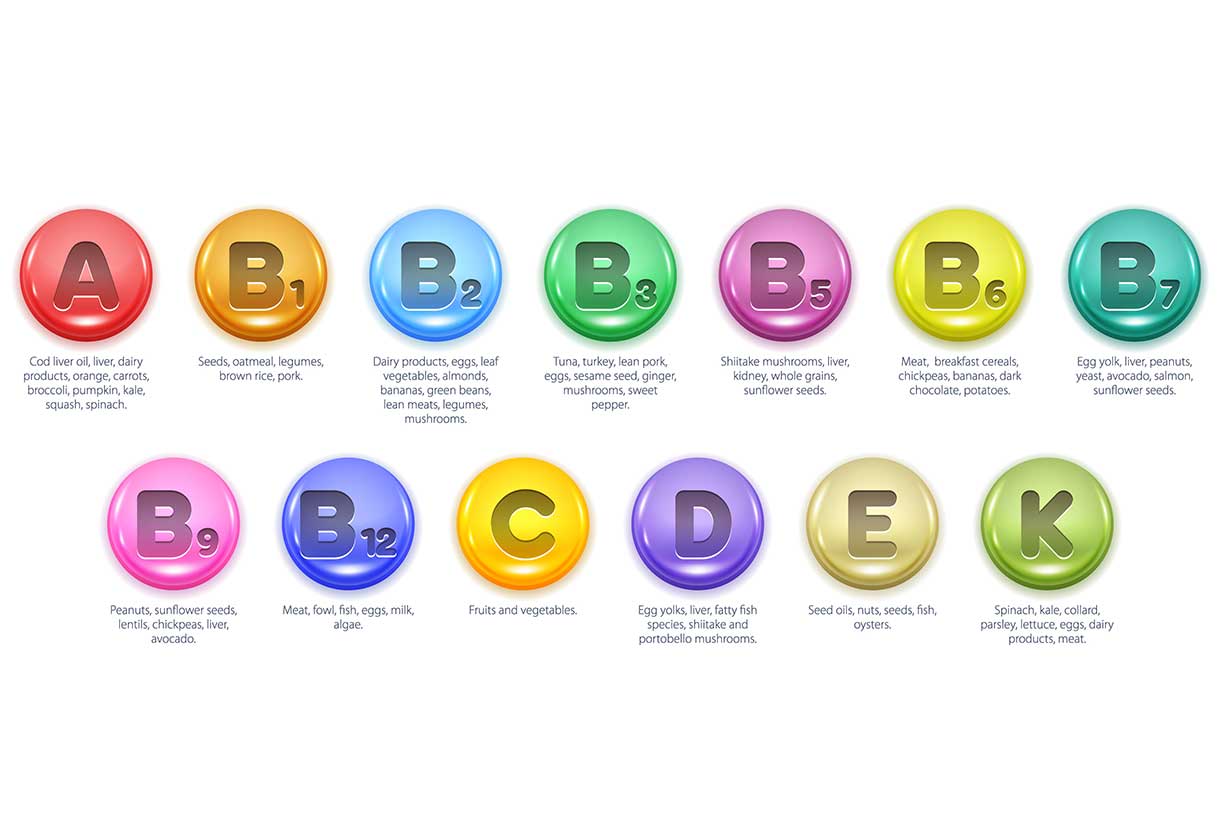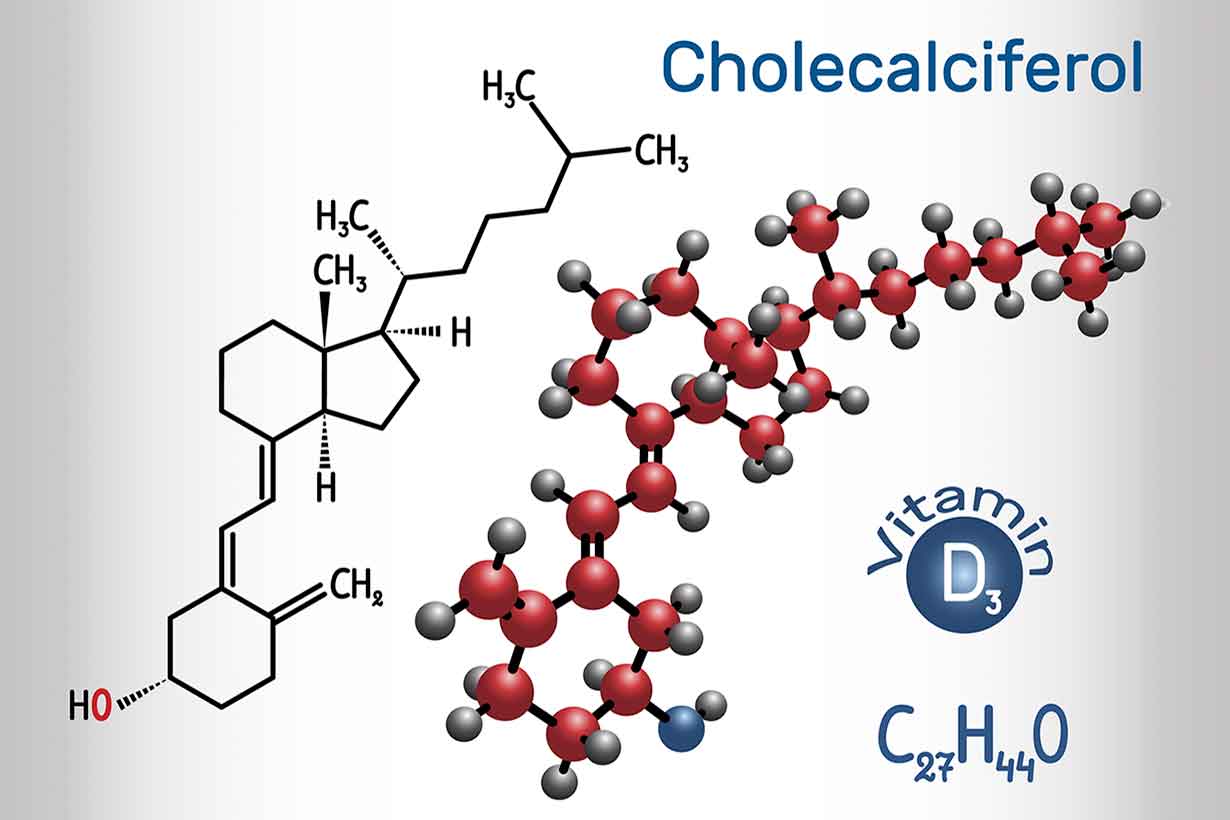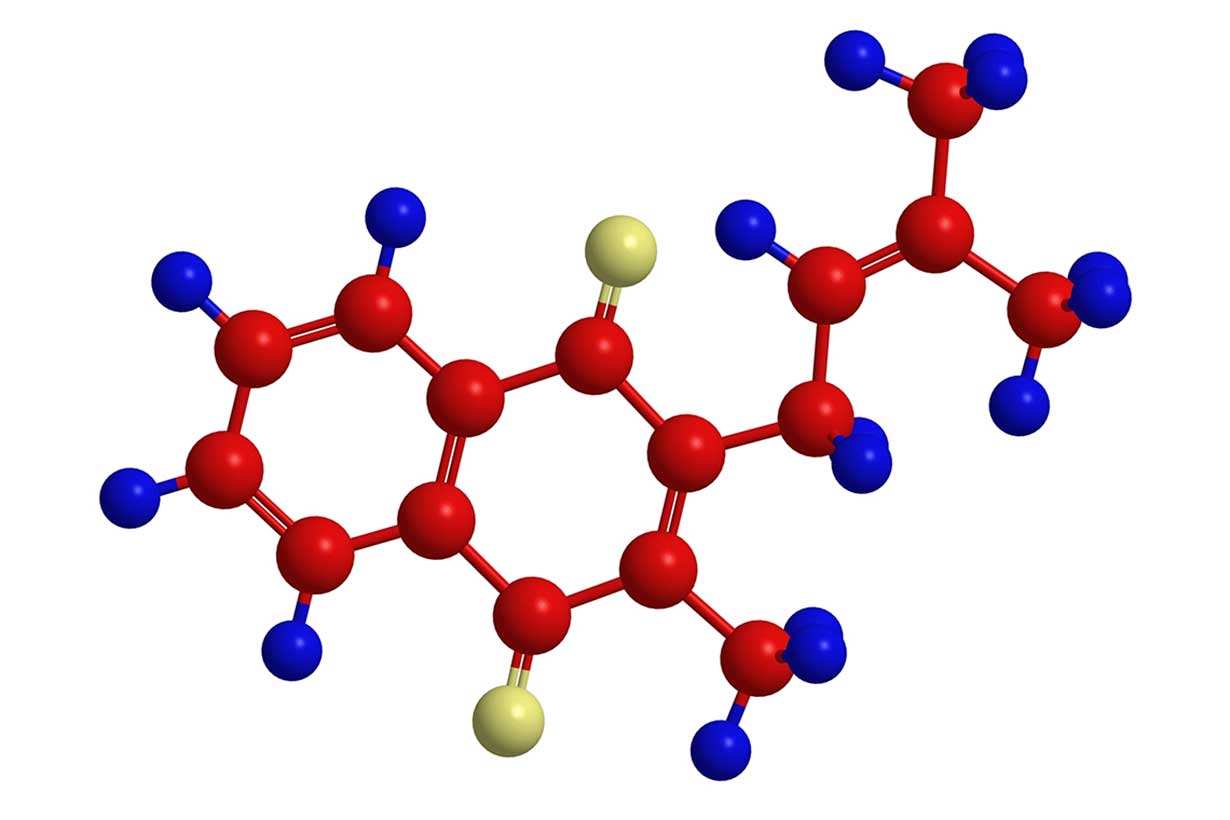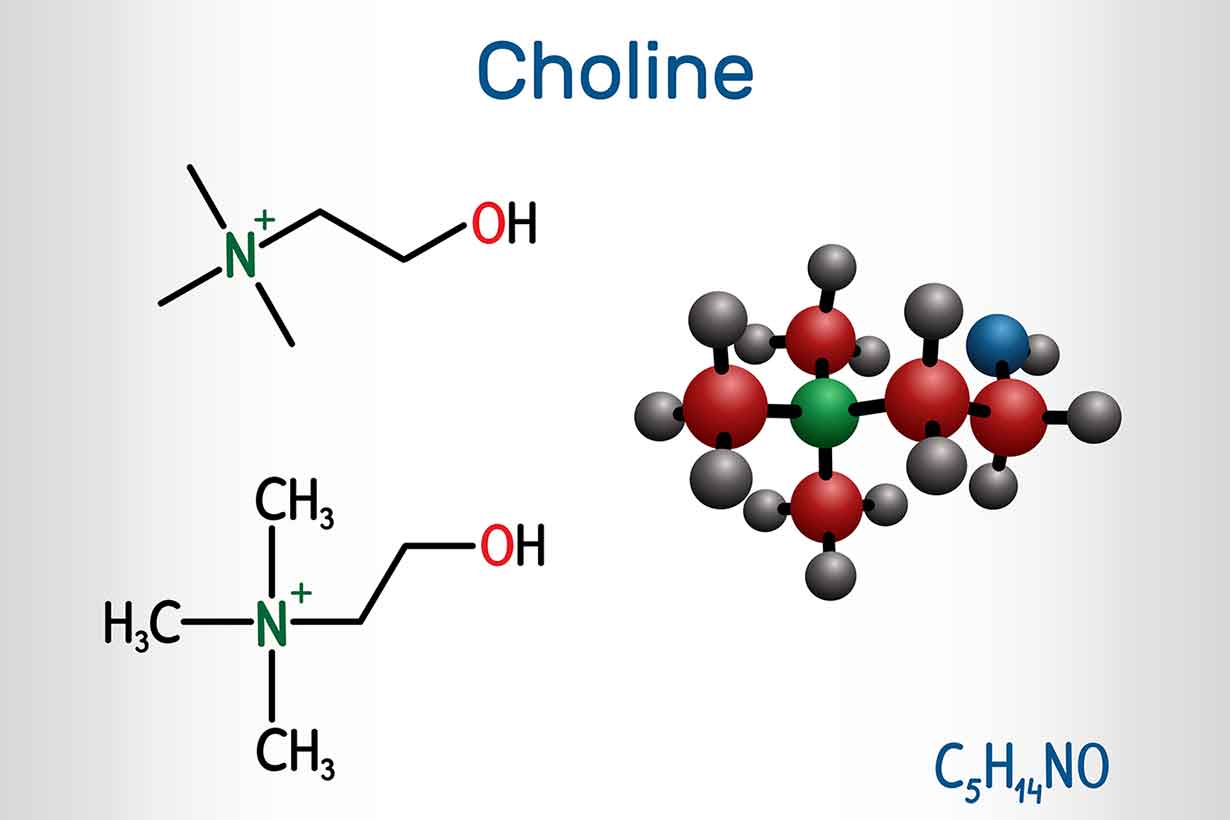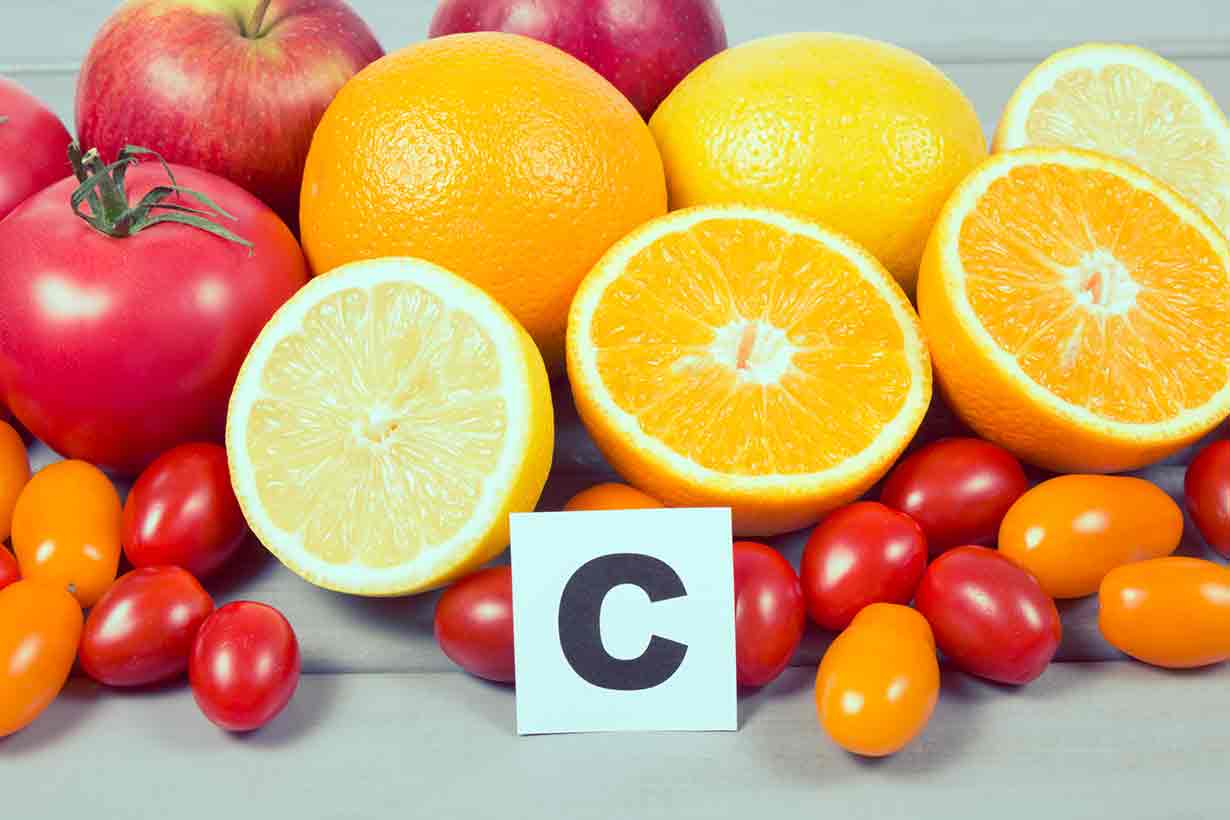This article explains what fat-soluble vitamins are, why they’re important, how much we need, and the best dietary sources.
Additionally, we explore some key considerations for safely consuming these vitamins at the recommended levels.
What Are Fat-Soluble Vitamins?
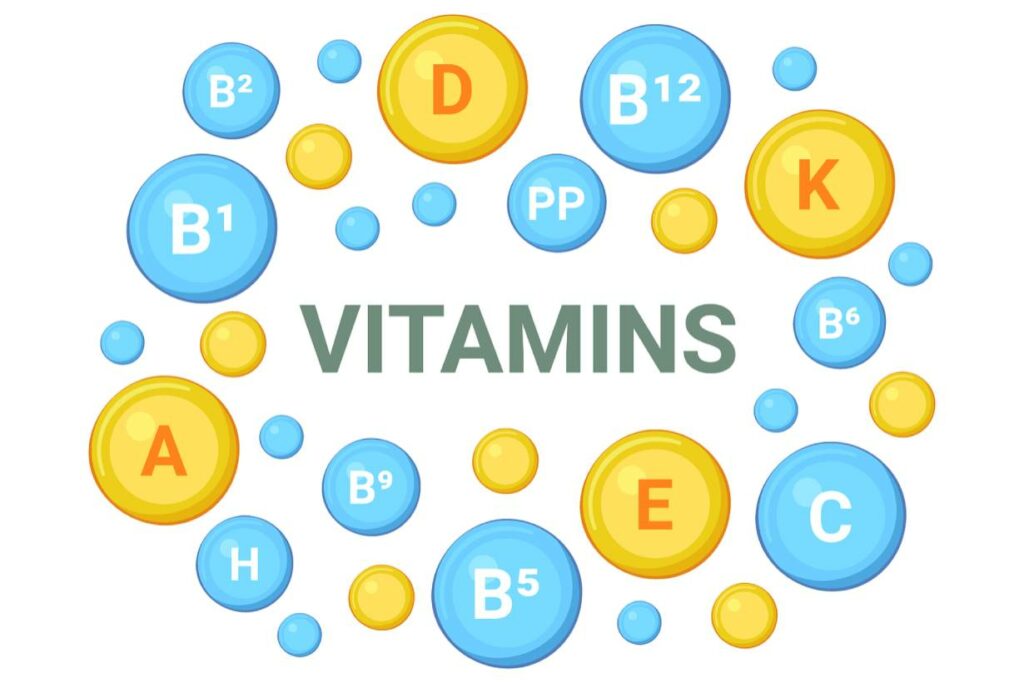
Fat-soluble vitamins are specific vitamins absorbed alongside fats in the diet within the small intestine (1).
Unlike water-soluble vitamins, fat-soluble vitamins have better absorption rates when consumed with dietary fat (2).
There are four fat-soluble vitamins:
- Vitamin A
- Vitamin D
- Vitamin E
- Vitamin K
Since these vitamins are fat-soluble, the human body can store them in adipose tissue (body fat). The liver also acts as a storage organ for fat-soluble vitamins, and it can store and release the vitamins as required (3).
Because fat-soluble vitamins can be stored, we do not need to consume them in the same concentrations as water-soluble vitamins (like vitamin C). However, it is possible to over-consume them, potentially leading to toxicity issues, which we will explore later in this guide.
We can obtain fat-soluble vitamins either from our diet or supplements. In the case of vitamin D, sensible sun exposure is another way to increase vitamin D stores.
Among the four fat-soluble vitamins, vitamin D has been categorized as a ‘dietary component of public health concern for the general U.S population’ by the Dietary Guidelines for Americans (4).
This designation is due to the relatively widespread prevalence of deficiency and insufficiency rates. For instance, a 2023 study found that approximately 20% of middle-aged and older adults in the United States were deficient in Vitamin D (5).
What Functions Do Fat-Soluble Vitamins Have in the Body?
Fat-soluble vitamins play crucial roles in the body and are essential for human health, hence their designation as “essential” vitamins.
The table below summarizes the key functions of each fat-soluble vitamin (6, 7, 8, 9, 10, 11, 12, 13, 14):
| Vitamin | Key functions |
|---|---|
| Vitamin A | Plays a role in the immune system. Helps to support healthy skin. Some provitamin A carotenoids have antioxidant properties. Important for vision and maintaining and supporting healthy eyes. Plays an important part in cell growth and development. |
| Vitamin D | Has important roles in the immune system. Promotes healthy bone health and facilitates the absorption of calcium and phosphorus. Plays a key role in cell growth and apoptosis (cell death), which may potentially help to prevent the growth of abnormal cells. Helps to support muscle strength and function. |
| Vitamin E | Vitamin E has antioxidant properties that help to protect cells against free-radical damage. Plays a key role in skin health. Helps to boost immune the immune system to protect against viruses. Has a role in the widening of blood vessels and preventing blood clots. May help to prevent the oxidation of low-density lipoprotein cholesterol (LDL-C). Oxidized LDL-C plays a role in the development of atherosclerosis (a build-up of plaque in the arteries). |
| Vitamin K | Plays a key role in bone health and calcium regulation. Vitamin K is essential for blood clotting. May play a role in preventing arterial calcification – a build-up of plaque in the arteries. However, there are mixed findings from existing studies and research is ongoing. |
How Much Do We Need?
The next important question regarding fat-soluble vitamins is: how much do we require?
Intake recommendations for each fat-soluble vitamin are made based on age and sex.
These recommended daily allowances (RDAs) are designed to be an intake level that supports good health for the majority of people (15).
The table below shows the RDA for each fat-soluble vitamin by sex and age group (16, 17, 18, 19).
| Vitamin | Male | Female |
|---|---|---|
| RDA for vitamin A | <6 months: 400 mcg RAE 7-12 months: 500 mcg RAE 1-3 years: 300 mcg RAE 4-8 years: 400 mcg RAE 9-13 years: 600 mcg RAE 14-18 years: 900 mcg RAE >19 years: 900 mcg RAE | <6 months: 400 mcg RAE 7-12 months: 500 mcg RAE 1-3 years: 300 mcg RAE 4-8 years: 400 mcg RAE 9-13 years: 600 mcg RAE 14-18 years: 700 mcg RAE 750 mcg (pregnancy) 1,200 mcg (lactation) >19 years: 700 mcg RAE 770 mcg (pregnancy) 1300 mcg (lactation) |
| RDA for vitamin D | 10-12 months: 10 mcg 1-13 years: 15 mcg 14-18 years: 15 mcg 19-50 years: 15 mcg 51-70 years: 15 mcg >70 years: 20 mcg | 0-12 months: 10 mcg 1-13 years: 15 mcg 14-18 years: 15 mcg 19-50 years: 15 mcg 51-70 years: 15 mcg >70 years: 20 mcg |
| RDA for vitamin E | 0-6 months: 4 mg 7-12 months: 5 mg 1-3 years: 6 mg 4-8 years: 7 mg 9-13 years: 11 mg >14 years: 15 mg | 0-6 months: 4 mg 7-12 months: 5 mg 1-3 years: 6 mg 5-8 years: 7 mg 9-13 years: 11 mg >14 years: 15 mg 15 mg (pregnancy) 19 mg (lactation) |
| Adequate intake* (AI) for vitamin K | 0-6 months: 2.0 mcg 7-12 months: 2.5 mcg 1-3 years: 30 mcg 4-8 years: 55 mcg 9-13 years: 60 mcg 14-18 years: 75 mcg >19 years: 120 mcg | 0-6 months: 2.0 mcg 7-12 months: 2.5 mcg 1-3 years: 30 mcg 4-8 years: 55 mcg 9-13 years: 60 mcg 14-18 years: 75 mcg >19 years: 90 mcg |
What Are the Best Dietary Sources of Fat-Soluble Vitamins?
A wide range of foods provide significant quantities of each fat-soluble vitamin.
The following table suggests five foods that provide substantial levels of each fat-soluble vitamin (20, 21, 22, 23, 24, 25, 26, 27, 28, 29, 30, 31, 32, 33, 34, 35, 36, 37, 38, 39).
| Fat-soluble vitamin | Best Dietary Sources |
|---|---|
| Vitamin A | Beef liver: 9440 mcg RAE per 100g Eel: 1140 mcg RAE per 100g Carrots: 852 mcg RAE per 100g Sweet potatoes: 787 mcg RAE per 100g Spinach: 524 mcg RAE per 100g Further information: 30 Foods High In Vitamin A |
| Vitamin D | UV-exposed cremini mushrooms: 31.9 mcg per 100g Salmon: 16.7 mcg per 100g Swordfish: 16.6 mcg per 100g Atlantic mackerel: 16.1 mcg per 100g Swordfish: Cod liver oil: 11.2 mcg per 4.5g teaspoon Further information: 30 Foods High In Vitamin D |
| Vitamin E | Sunflower seeds: 35.2 mg per 100g Almonds: 25.6 mg per 100g Toasted wheat germ: 16 mg per 100g Hazelnuts: 15.3 mg per 100g Canola oil: 2.45 mg per 14g tbsp Further information: 30 Foods High In Vitamin E |
| Vitamin K | Spinach: 494 mcg per 100g Beet greens: 484 mcg per 100g Kale: 484 mcg per 100g Collard greens: 407 mcg per 100g Broccoli: 141 mcg per 100g Vitamin K is available in two primary forms: vitamin K1 from plant foods, and vitamin K2 from animal-based foods and fermented foods. Further information Vitamin K1: 30 Foods High In Vitamin K1 Vitamin K2: 20 Foods High In Vitamin K2 |
Avoid Excessive Intakes of Fat-Soluble Vitamins
As previously mentioned, fat-soluble vitamins are stored in adipose tissue and the liver, so we don’t need them in as high concentrations as some other vitamins.
Since we can store these vitamins, excessive intake may result in accumulating levels that may potentially lead to toxicity and adverse effects.
For example, excessive intake of vitamin D can lead to too much calcium in the blood, which can cause calcification (a build-up of plaque) (40).
Likewise, excessive intake of vitamin A can cause hypervitaminosis A, where vitamin A levels in the body reach toxic levels. This can result in symptoms such as nausea, dizziness, and blurred vision, and even organ damage in cases of chronic hypervitaminosis A (41).
For these reasons, it is important to note the ‘tolerable upper intake levels’ established by the Food and Nutrition Board (FNB) at the Institute of Medicine (42).
Regularly exceeding these levels may lead to toxicity symptoms. However, high-dose supplementation rather than dietary intake is the most common reason people over-consume these fat-soluble vitamins.
Tolerable Upper Intake Levels For Each Fat-Soluble Vitamin
According to the FNB, vitamin K has a “low potential for toxicity,” so tolerable upper intake levels have not been established.
However, tolerable upper intake levels have been established for vitamins A, D, and E. These levels are based on age and are the same for both sexes, as detailed in the following table (43, 44, 45):
| Vitamin | Tolerable Upper Intake Level |
|---|---|
| Vitamin A | 0-12 months: 600 mcg 1-3 years: 600 mcg 4-8 years: 900 mcg 9-13 years: 1700 mcg 14-18 years: 2800 mcg >19 years: 3000 mcg |
| Vitamin D | 0-6 months: 25 mcg 7-12 months: 38 mcg 1-3 years: 63 mcg 4-8 years: 75 mcg 9-18 years: 100 mcg >19 years: 100 mcg |
| Vitamin E | 1-3 years: 200 mg 4-8 years: 300 mg 9-13 years: 600 mg 14-18 years: 800 mg >19 years: 1000 mg |
References
- https://www.ncbi.nlm.nih.gov/books/NBK534869/
- https://www.ncbi.nlm.nih.gov/pmc/articles/PMC4810759/
- https://extension.colostate.edu/topic-areas/nutrition-food-safety-health/fat-soluble-vitamins-a-d-e-and-k-9-315/
- https://www.dietaryguidelines.gov/resources/2020-2025-dietary-guidelines-online-materials/food-sources-select-nutrients
- https://www.frontiersin.org/articles/10.3389/fnut.2023.1163737/full
- https://ods.od.nih.gov/factsheets/VitaminA-HealthProfessional/
- https://ods.od.nih.gov/factsheets/VitaminA-Consumer/
- https://ods.od.nih.gov/factsheets/VitaminD-HealthProfessional/
- https://ods.od.nih.gov/factsheets/VitaminD-Consumer/
- https://www.sciencedirect.com/science/article/pii/S1044579X20301140
- https://ods.od.nih.gov/factsheets/Vitamine-HealthProfessional/
- https://ods.od.nih.gov/factsheets/VitaminE-Consumer/
- https://ods.od.nih.gov/factsheets/VitaminK-HealthProfessional/
- https://ods.od.nih.gov/factsheets/VitaminK-Consumer/
- https://www.ncbi.nlm.nih.gov/books/NBK45182/
- https://ods.od.nih.gov/factsheets/VitaminA-HealthProfessional/#h2
- https://ods.od.nih.gov/factsheets/VitaminD-HealthProfessional/#h3
- https://ods.od.nih.gov/factsheets/Vitamine-HealthProfessional/#h2
- https://ods.od.nih.gov/factsheets/VitaminK-HealthProfessional/#h2
- https://fdc.nal.usda.gov/fdc-app.html#/food-details/168626/nutrients
- https://fdc.nal.usda.gov/fdc-app.html#/food-details/174194/nutrients
- https://fdc.nal.usda.gov/fdc-app.html#/food-details/170394/nutrients
- https://fdc.nal.usda.gov/fdc-app.html#/food-details/168484/nutrients
- https://fdc.nal.usda.gov/fdc-app.html#/food-details/168463/nutrients
- https://fdc.nal.usda.gov/fdc-app.html#/food-details/168557/nutrients
- https://fdc.nal.usda.gov/fdc-app.html#/food-details/173692/nutrients
- https://fdc.nal.usda.gov/fdc-app.html#/food-details/173704/nutrients
- https://fdc.nal.usda.gov/fdc-app.html#/food-details/175119/nutrients
- https://fdc.nal.usda.gov/fdc-app.html#/food-details/173577/nutrients
- https://fdc.nal.usda.gov/fdc-app.html#/food-details/170562/nutrients
- https://fdc.nal.usda.gov/fdc-app.html#/food-details/170567/nutrients
- https://fdc.nal.usda.gov/fdc-app.html#/food-details/173896/nutrients
- https://fdc.nal.usda.gov/fdc-app.html#/food-details/170583/nutrients
- https://fdc.nal.usda.gov/fdc-app.html#/food-details/172336/nutrients
- https://fdc.nal.usda.gov/fdc-app.html#/food-details/168463/nutrients
- https://fdc.nal.usda.gov/fdc-app.html#/food-details/170376/nutrients
- https://fdc.nal.usda.gov/fdc-app.html#/food-details/169238/nutrients
- https://fdc.nal.usda.gov/fdc-app.html#/food-details/170407/nutrients
- https://fdc.nal.usda.gov/fdc-app.html#/food-details/169967/nutrients
- https://www.ncbi.nlm.nih.gov/pmc/articles/PMC5986531/
- https://www.ncbi.nlm.nih.gov/books/NBK532916/
- https://www.sciencedirect.com/science/article/pii/S0022316622080865
- https://ods.od.nih.gov/factsheets/VitaminA-HealthProfessional/#h17
- https://ods.od.nih.gov/factsheets/VitaminD-HealthProfessional/#h36
- https://ods.od.nih.gov/factsheets/Vitamine-HealthProfessional/#h14

